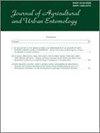Development of Hippotion celerio (L.) (Lepidoptera: Sphingidae) on Cissus quadrangularis L. (Vitaceae) in Bangalore, India
Q2 Agricultural and Biological Sciences
The Journal of Agricultural and Urban Entomology
Pub Date : 2020-12-23
DOI:10.3954/1523-5475-36.1.120
引用次数: 0
Abstract
Approximately 3000 plant species are used in traditional medicine practices in India, such as Ayurveda, Homeopathy, Siddha and Yunani (Pandey et al. 2013). Cissus quadrangularis L. (Vitaceae), an indigenous plant in India, is being evaluated for its therapeutic efficacy (Ravishankar & Shukla 2007).Cissus quadrangularis is characterized by a thick quadrangular fleshy stem, and leaves with smooth margins. It is commonly grown in warm tropical climates in India, Sri Lanka, Java and West Africa (Udupa et al. 1970). The plant is often called “Hadjod” in Hindi and “Asthisamdhani” in Sanskrit due to its potential to speed the healing of fractured bones (Sivarajan & Balachandran 1994). In Kenya and Sri Lanka, the plant is used to treat piles, gout, venereal diseases, leukorrhea and dysentery (HolfordWalker 1981, Khan et al. 1991, Yoganarsimhan 2000). The stem is used to treat scurvy, irregular menstruation, otorrhoea and epistaxis, and the root is used to treat bone fracture in India (Nadkarni 1954, Prasad & Udupa 1963, Kumbhojkar et al. 1991, Sandhip & Sheetal 2014, Brahmkshatriya et al. 2015). During a regular survey of pests of economically important crops in 2016, a new lepidopteran pest was encountered on C. quadrangularis grown as medicinal plants in the backyard of a house near Rabindranath Tagore Nagar, Bangalore, Karnataka, India. Caterpillars were bought back to the laboratory, reared on C. quadrangularis, and the resulting moths were identified by Dr. Janakiraman Poorani at Indian Council of Agricultural Research – National Bureau of Agricultural Insect Resources (ICAR-NBAIR), Bangalore, Karnataka, India, asHippotion celerio (L.) (Lepidoptera: Sphingidae). Hippotion celerio is found in Africa, India and Sri Lanka, and, as an invasive species in southern Europe and Australia. This detection represents the first report of H. celerio in Bangalore. Chatterjee & Ram (1969) reportedH. celerio from Poona, India, and described coloration of last instar印度班加罗尔四棱叶蝉(Vitaceae)上小叶蝉的发育(鳞翅目:蜘蛛科)
印度传统医学实践中使用了大约3000种植物,如阿育吠陀、顺势疗法、悉达和尤拉尼(Pandey et al. 2013)。目前正在对印度本土植物——四角仙桃(Vitaceae)的治疗效果进行评估(Ravishankar & Shukla 2007)。四角仙鹤的特点是茎粗大,呈四边形,肉质,叶边缘光滑。它通常生长在印度、斯里兰卡、爪哇和西非的温暖热带气候中(Udupa et al. 1970)。这种植物在印地语中通常被称为“Hadjod”,在梵语中被称为“Asthisamdhani”,因为它有加速骨折愈合的潜力(Sivarajan & Balachandran 1994)。在肯尼亚和斯里兰卡,这种植物被用来治疗痔疮、痛风、性病、白带和痢疾(HolfordWalker 1981, Khan et al. 1991, Yoganarsimhan 2000)。在印度,茎部用于治疗坏血病、月经不调、耳漏和鼻出血,根部用于治疗骨折(Nadkarni 1954, Prasad & Udupa 1963, Kumbhojkar等人1991,Sandhip & Sheetal 2014, Brahmkshatriya等人2015)。在2016年对重要经济作物有害生物的定期调查中,在印度卡纳塔克邦班加罗尔Rabindranath Tagore Nagar附近的一所房屋后院作为药用植物种植的四角蛾(C. quadrangularis)上发现了一种新的鳞翅目有害生物。将幼虫买回实验室,饲养在C. quadrangularis上,由印度卡纳塔克邦邦班加罗尔的印度农业研究委员会-国家农业昆虫资源局(icar - nair)的Janakiraman Poorani博士鉴定为hippotion celerio (L.)(鳞翅目:Sphingidae)。希波tion celerio产于非洲、印度和斯里兰卡,是南欧和澳大利亚的一种入侵物种。这是在班加罗尔发现的第一例塞莱里奥氏杆菌。查特吉和拉姆(1969)报道了h。来自印度普那的celerio,描述了最后一颗星的颜色
本文章由计算机程序翻译,如有差异,请以英文原文为准。
求助全文
约1分钟内获得全文
求助全文
来源期刊

The Journal of Agricultural and Urban Entomology
Agricultural and Biological Sciences-Insect Science
CiteScore
1.40
自引率
0.00%
发文量
2
期刊介绍:
The Journal of Agricultural and Urban Entomology (JAUE) (Journal of Agricultural Entomology, Jan 1984 - Oct 1998 volumes 1-15) is published under the auspices of the South Carolina Entomological Society (SCES). The Journal publishes contributions of original research concerning insects and other arthropods of agricultural and urban importance to include those affecting humans, livestock, poultry, and wildlife. JAUE is particularly dedicated to the publication of articles and notes pertaining to applied entomology, although it will accept suitable contributions of a fundamental nature related to agricultural and urban entomology.
 求助内容:
求助内容: 应助结果提醒方式:
应助结果提醒方式:


